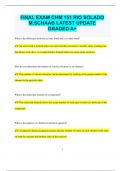Exam (elaborations)
FINAL EXAM CHM 151 RIO SOLADO M.SCHAAB LATEST UPDATE GRADED A+
- Course
- Institution
FINAL EXAM CHM 151 RIO SOLADO M.SCHAAB LATEST UPDATE GRADED A+ What is the difference between an ionic bond and a covalent bond? An ionic bond is formed when one atom transfers electrons to another atom, creating ions that attract each other. A covalent bond is formed when two atoms sha...
[Show more]



